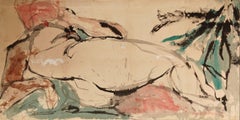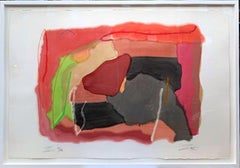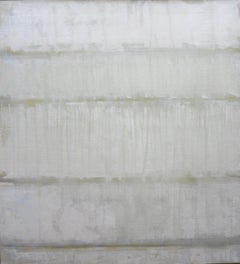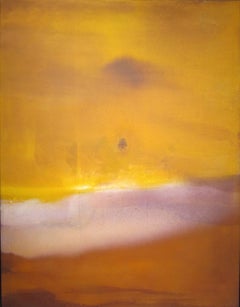Willem de Looper Abstract Paintings
to
1
1
Overall Width
to
Overall Height
to
1
1
1
1
1
1
1
666
627
362
342
1
Artist: Willem de Looper
Willem de Looper
By Willem de Looper
Located in Washington, DC
Watercolor by Willem De Looper (1932-2009). Painting is signed "de Looper" and dated 76' lower right. Painting measures 20" x 8".
Willem De Looper was a Washington D.C. abstract...
Category
1970s Color-Field Willem de Looper Abstract Paintings
Materials
Paper, Watercolor
$2,925 Sale Price
35% Off
Related Items
"Untitled" Vivian Springford, 1960s Color Field Abstract Expressionist Forms
Located in New York, NY
Vivian Springford
Untitled (Rice Paper Mounting), 1963-65
Signed lower left
Ink, watercolor and acrylic on rice paper laid to canvas
27 1/4 x 53 3/8 inches
A contributor to Abstrac...
Category
1960s Color-Field Willem de Looper Abstract Paintings
Materials
Canvas, Ink, Watercolor, Rice Paper
$9,900 Sale Price
44% Off
H 28.75 in W 54.75 in
Dexter's Choice State II, signed mixed media watercolor (unique variant), Framed
By Larry Zox
Located in New York, NY
Larry Zox
Dexter's Choice, State II, ca. 1990
Mixed media, Watercolor pochoir, and Oil stick Wax, Water-Based Crayons, on heavy Arches museum watercolor rag paper with deckled edges
...
Category
1990s Color-Field Willem de Looper Abstract Paintings
Materials
Crayon, Mixed Media, Oil, Watercolor, Graphite, Monoprint
$10,000
H 42 in W 62 in D 1.5 in
Geometric Gems, Yellow, Purple, Pink Checker Pattern Squared Grid, Bauhaus Tiles
By Natalia Roman
Located in Barcelona, ES
These series of paintings by Natalia Roman gather their inspiration from geometric, minimalist shapes and paintings from the beginning of Modernism, with a special emphasis on Art De...
Category
2010s Color-Field Willem de Looper Abstract Paintings
Materials
Oil, Archival Paper
Pink Geometric Altar Diptych, Surreal Landscape, Modern Monument Architecture
By Natalia Roman
Located in Barcelona, ES
These series of paintings by Natalia Roman gather their inspiration from geometric, minimalist shapes and paintings from the beginning of Modernism, with a special emphasis on Art De...
Category
2010s Color-Field Willem de Looper Abstract Paintings
Materials
Acrylic, Archival Paper
$536 Sale Price
33% Off
H 28 in W 40 in
Contemporary Gestural Abstraction Color Field Painting Woman Artist Metallic Art
By Francine Tint
Located in Surfside, FL
Bermuda Triangle, in vivid metallic tones, gold and bronze, on Arches Paper. framed. Signed, titled and dated verso. Size includes frame. This is an abstract work and can be hung eit...
Category
1980s Color-Field Willem de Looper Abstract Paintings
Materials
Acrylic, Archival Paper
Echoes No.2 - Colour field blue, 100x100cm, Limited Edition of 10.
By Ugne Pouwell
Located in London, GB
'Echoes No.2 '
London, United Kingdom 2024
Limited edition of 10
Pinted on archival Hahnehmule Photo rag paper, with care and attention to detail.
The process involves layerin...
Category
21st Century and Contemporary Color-Field Willem de Looper Abstract Paintings
Materials
Glass, Ink, Archival Ink, Archival Paper
$1,393
H 39.38 in W 39.38 in D 0.2 in
Abstract Painting of Vivid Colors Painting of Layered Curvilinear Forms, Paper
By Natalia Roman
Located in Barcelona, ES
"Layered Curvilinear Forms" is an abstract painting diptych by Spanish artist Natalia Roman. It is a beautiful series of rhythmic brushstrokes and shapes combined with subtle tones a...
Category
2010s Color-Field Willem de Looper Abstract Paintings
Materials
Acrylic, Oil Crayon, Rag Paper
Body in blue - Colour field blue, 100x100cm, Limited Edition of 10.
By Ugne Pouwell
Located in London, GB
'Body in blue'
London, United Kingdom 2024
Limited edition of 10
Pinted on archival Hahnehmule Photo rag paper, with care and attention to detail.
The process involves layerin...
Category
21st Century and Contemporary Color-Field Willem de Looper Abstract Paintings
Materials
Glass, Ink, Archival Ink, Archival Paper
$1,310
H 39.38 in W 39.38 in D 0.2 in
Moon Phase Scheme on Black, Mauve and Coral Circles, Primary Geometry Astronomy
By Natalia Roman
Located in Barcelona, ES
These series of paintings by Natalia Roman gather their inspiration from geometric, minimalist shapes and paintings from the beginning of Modernism, with a special emphasis on Art De...
Category
2010s Color-Field Willem de Looper Abstract Paintings
Materials
Acrylic, Rag Paper
Houses of town. 1972, watercolor on paper, 55x75, 5 cm
By Olgerts Jaunarajs
Located in Riga, LV
Houses of town. 1972, watercolor on paper, 55x75,5 cm
Olgerts Jaunarajs (1907-2003)
He was so-called legend of abstract expressionism in the Latvia...
Category
1970s Color-Field Willem de Looper Abstract Paintings
Materials
Paper, Watercolor
$730 Sale Price
35% Off
H 21.66 in W 29.73 in D 0.04 in
Joanne Mattera, Riz 13, 2020, oil on paper, 14.25x14.25 in, Color Abstraction
By Joanne Mattera
Located in Darien, CT
Summer is Joanne Mattera’s time to work on paper. When she is fully engaged, as she has been with Riz, that time slides well into autumn. These are paintings on paper, oil and wax on...
Category
2010s Color-Field Willem de Looper Abstract Paintings
Materials
Oil, Archival Paper
$1,500
H 14.25 in W 14.25 in
Contemporary Gestural Abstraction "Boat Moon" Color Field Painting Woman Artist
By Francine Tint
Located in Surfside, FL
Boat Moon, in vivid blues a range of blue tones on Arches Paper. not framed. Signed, titled and dated verso.
Francine Tint is a New York-based American abstract expressionist painter and costume designer...
Category
1990s Color-Field Willem de Looper Abstract Paintings
Materials
Acrylic, Archival Paper
Previously Available Items
Untitled, 1974
By Willem de Looper
Located in Wilton Manors, FL
Willem De Looper (1932-2009). Untitled, 1974. Acrylic on canvas, 44 x 45 inches; 46 x 47 inches framed. Signed, dated and tiled en verso. Excellent condition with no damage or conservation. Max Protetch Gallery label affixed en verso.
Biography:
Willem Johan de Looper (October 30, 1932 – January 30, 2009) was an American abstract artist, and chief curator at The Phillips Collection.
Willem de Looper, born October 30, 1932, was the third child of Wilhelmina Johanna and Henri Bastiaan de Looper. He grew up in The Hague and had a Montessori education. During the German occupation of the Netherlands during World War II, the family moved three times, once settling with a family friend who was a musician. This started a lifelong love of music that would later influence de Looper's visual art. As the war ended and American publications, like The New Yorker, Saturday Evening Post, and Life became available, de Looper immersed himself in their content and spent a great deal of time copying the illustrations. He also developed a fascination with and love of America and American culture.[2]
In 1950, at age 17, de Looper immigrated to Washington, D.C., joining his older brother Hans who worked at the International Monetary Fund. He started an undergraduate education in business and economics and then changed his major to art.[2] At American University de Looper studied with Robert Gates, Sarah Marindah Baker, and Ben Summerford. (De Looper considered Summerford his greatest mentor.) De Looper continued to live with his brother during his university years and his brother financed his education. He traveled frequently home to visit his parents as well as Dutch art museums. After graduating from American University in 1957, de Looper served two years in the U.S. Army in Germany.[2]
During his tour in Europe, in 1958, he attended the Brussels World's Fair and saw Abstract Expressionist paintings for the first time in the American Pavilion. He traveled as much as he could throughout the continent to see art and collected and studied art magazines and journals. He also married during this time, Lili Mentrop, a childhood friend, but the marriage was brief.[2]
After returning from the Army in 1959, de Looper worked as a museum guard for the Phillips Collection. He claimed that during 1962-1963, he filled a notebook with watercolors influenced by Phillips Collection artists such as Paul Klee, John Marin, and Arthur Dove. He experimented with styles and processes of the Color Field artists (rolling, pouring, and staining with paint.) In the 1960s, he exhibited his work at the Franz Bader Gallery, International Monetary Fund, Society of Washington Artists, and Jefferson Place Gallery.[2]
In 1966, de Looper had his first solo exhibition at the Jefferson Place Gallery in Washington, DC. The gallery would go on to host solo exhibitions of his work every year through 1974.After his second marriage in 1969 to Frauke Weber, the couple moved into the St. Regis building on California Street in Northwest Washington D.C. where he finally had a large studio space, which brought on a period of working on larger canvases. De Looper continued pursuing his career as an artist while working for the Philips Collection, and became assistant curator in 1972, then curator at the museum from 1982 - 1987.[2]
De Looper has shown at many established galleries and museums such as The National Gallery of Art, The Phillips Collection, Smithsonian American Art Museum, Hirshhorn Museum and Sculpture Garden and Corcoran Gallery of Art. The Phillips Collection hosted solo shows of his work in 1975 and 2002.[1]
He died January 30, 2009 of emphysema.
SELECTED SOLO EXHIBITIONS
2015 “Willem De Looper, Stained Paintings: 1964-1970” Hemphill Gallery, Washington DC
2013 “Willem de Looper: All That Jazz...Works from the 80s and 90s,” Atrium Gallery, St. Louis, MO
“Washington Art Matters: 1940s-1980s,” Katzen Arts Center, American University, Washington, DC
2012 “Willem de Looper: Paintings 1968-72,” Hemphill Fine Arts, Washington DC
“The Morris at Twenty,” Morris Museum of Art, Augusta, GA
2011 “The Big Reveal,” Kemper Museum of Contemporary Art, Kansas City, MO
2009 “Willem de Looper – In Memoriam,” Atrium Gallery, St. Louis, MO
“Memorial Exhibition,” The Phillips Collection, Washington, DC
2008 “Willem de Looper,” Katzen Arts Center, American University, Washington, DC
PASS Gallery, Washington, DC
2006 PASS Gallery, Washington, DC
2002 “Willem de Looper: A Birthday Celebration,” The Phillips Collection, Washington, DC
2001 “New Paintings,” Alex Gallery, Washington, DC
2000 “Art Paris,” Galerie Sacha Tarassoff, Paris, France
“Recent Paintings,” Atrium Gallery, St. Louis, MO
“Willem de Looper: Paintings 1998-2000,” Alex Gallery, Washington, DC
1998 “Willem de Looper: Recent Paintings,” Troyer Fitzpatrick Lassman Gallery, Washington, DC
“New Paintings,” PASS, Washington, DC
“Recent Work,” Atrium Gallery, St. Louis, MO
1997 Troyer Fitzpatrick Lassman Gallery, Washington DC
“Willem de Looper Retrospective,” University of Maryland, College Park, MD
1996 “Uno (only one),” Atrium Gallery, St. Louis, MO (two-person exhibition)
Troyer Fitzpatrick Lassman Gallery, Washington, DC
“Sketchbooks and Works on Paper,” The Phillips Collection, Washington, DC
“Paintings from 1960-1976,” Federal Reserve Board, jointly with the National Academy of Sciences, Washington, DC
1995 “New Work,” Atrium Gallery, St. Louis, MO
Troyer Fitzpatrick Lassman Gallery Washington, DC
“Willem De Looper: Paintings and Painted Objects,” Pavilion of Fine Arts, Montgomery College, Takoma Park, MD
“Willem de Looper: Sketchbooks and Small Paintings on Paper,” The Phillips Collection, Washington, DC
1994 “Recent Work,” Watkins Gallery, American University, Washington, DC
1993 Troyer Fitzpatrick Lassman Gallery, Washington, DC
1992 Atrium Gallery, St. Louis, MO
Jones Troyer Fitzpatrick Gallery, Washington, DC
1991 Smith Andersen Gallery, Palo Alto, CA
1990 “Works on Canvas and Paper,” Atrium Gallery, St. Louis, MO
1989 B.R. Kornblatt Gallery, Washington, DC
Jones Troyer Fitzpatrick Gallery, Washington, DC
1988 Shippee Gallery, New York, NY
Tilghman Gallery, Boca Raton, FL
1987 B.R. Kornblatt Gallery, Washington, DC
Tilghman Gallery, Boca Raton, FL
1986 “Area Exhibitions,” Corcoran Gallery of Art, Washington, DC
1985 Montgomery College, Takoma Park, MD
B.R. Kornblatt Gallery, Washington, DC
“Area Exhibitions,” Corcoran Gallery of Art, Washington, DC
1983 B.R. Kornblatt Gallery, Washington, DC
1982 Wald, Harkrader, and Ross, Washington, DC
1980 McIntosh/Drysdale Gallery, Washington, DC
“Area Exhibitions,” Corcoran Gallery of Art, Washington, DC
1979 Sarah Y. Rentschler Gallery, New York, NY
Galerie L., Hamburg, West Germany
1978 Max Protech Gallery, Washington, DC
The Catholic University of America, Washington, DC
Montgomery College, Takoma Park, MD
Jean-Marie Antone Gallery, Annapolis, MD
1977 Max Protech Gallery, Washington, DC
Fraser’s Stable Gallery, Washington, DC
1976 Max Protech Gallery, Washington, DC
“The Golden Door: Artist Immigrants of America, 1876-1976,” Hirshhorn Museum and Sculpture Garden, Washington, DC
Three-person exhibition, Corcoran Gallery of Art, Washington, DC
1975 Max Protech Gallery, Washington, DC
“Large Paintings and Works on Paper,” The Phillips Collection, Washington, DC
“Paintings from 1962-1975,” Northern Virginia Community College, Annandale, VA
1974 Montgomery College, Takoma Park, MD
Jefferson Place Gallery, Washington, DC
1972 Jefferson Place Gallery, Washington, DC
1971 The Athenaeum of Philadelphia, Philadelphia, PA
1970 Jefferson Place Gallery, Washington, DC
Philomathean Gallery, University of Pennsylvania, Philadelphia, PA
“Washington, Twenty Years,” Baltimore Museum of Art, Baltimore, MD
1968 Jefferson Place Gallery, Washington, DC
“Group Seven,” Washington Gallery of Modern Art, Washington, DC
1967 Jefferson Place Gallery, Washington, DC
“Area Exhibitions,” Corcoran Gallery of Art, Washington, DC
1966 Jefferson Place Gallery, Washington, DC
1965 “Area Exhibitions,” Corcoran Gallery of Art, Washington, DC
SELECTED GROUP EXHIBITIONS
2017 “Peace,” Atrium Gallery, St. Louis, MO
“All the Blues”, Atrium Gallery, St. Louis, MO
“Abstraction,” Atrium Gallery, St. Louis, MO
2016 "From the Racks," Atrium Gallery, St. Louis, MO
2015 “Works on Paper,” Atrium Gallery, St. Louis, MO
2012 “RED,” Atrium Gallery, St. Louis, MO
2011 “The Big Reveal” Kemper Art Museum, Kansas City, MO
“SILVER,” 25th Anniversary Show, Atrium Gallery, St. Louis, MO
2010 “Art Chicago 2010,” Atrium Gallery, Chicago, IL
2009 “Art Chicago 2009,” Atrium Gallery, Chicago, IL
2008 “Choose One,” Atrium Gallery, St. Louis, MO
“Abstraction,” Atrium Gallery, St. Louis, MO
2007 “International Blitz,” Atrium Gallery, St. Louis, MO
2006 “Paper, Paper,” Atrium Gallery, St. Louis, MO
“Selections,” Atrium Gallery, St. Louis, MO
2005 “Holiday Group Show,” Atrium Gallery, St. Louis, MO
“With Spirit,” Atrium Gallery, St. Louis, MO
2004 CITIRAMA, St. Louis, MO
2004 Chesterfield Arts Gallery Exhibit, Chesterfield, MO
2004 “In the Cool of the Night,” Atrium Gallery, St. Louis, MO
2003 “Atrium at the Plaza,” St. Louis, MO
“Art Palm Beach,” Atrium Gallery, Palm Beach, FL
Atrium Gallery at HOK, St. Louis, MO
2002 “Scale It,” Atrium Gallery, St. Louis, MO
“Art Palm Beach,” Atrium Gallery, Palm Beach, FL
2000 “Recycled Paper III...
Category
1970s Color-Field Willem de Looper Abstract Paintings
Materials
Canvas, Acrylic
Zanzibar, 1971 (Abstract Expressionist colorfield painting)
By Willem de Looper
Located in Wilton Manors, FL
Willem De Looper (1932-2009). Zanzibar, 1971. Acrylic on canvas, 66 x 80 inches; 68 x 82 inches framed. Signed, dated and tiled en verso. Excellent condition with no damage or conservation.
Biography:
Willem Johan de Looper (October 30, 1932 – January 30, 2009) was an American abstract artist, and chief curator at The Phillips Collection.
Willem de Looper, born October 30, 1932, was the third child of Wilhelmina Johanna and Henri Bastiaan de Looper. He grew up in The Hague and had a Montessori education. During the German occupation of the Netherlands during World War II, the family moved three times, once settling with a family friend who was a musician. This started a lifelong love of music that would later influence de Looper's visual art. As the war ended and American publications, like The New Yorker, Saturday Evening Post, and Life became available, de Looper immersed himself in their content and spent a great deal of time copying the illustrations. He also developed a fascination with and love of America and American culture.[2]
In 1950, at age 17, de Looper immigrated to Washington, D.C., joining his older brother Hans who worked at the International Monetary Fund. He started an undergraduate education in business and economics and then changed his major to art.[2] At American University de Looper studied with Robert Gates, Sarah Marindah Baker, and Ben Summerford. (De Looper considered Summerford his greatest mentor.) De Looper continued to live with his brother during his university years and his brother financed his education. He traveled frequently home to visit his parents as well as Dutch art museums. After graduating from American University in 1957, de Looper served two years in the U.S. Army in Germany.[2]
During his tour in Europe, in 1958, he attended the Brussels World's Fair and saw Abstract Expressionist paintings for the first time in the American Pavilion. He traveled as much as he could throughout the continent to see art and collected and studied art magazines and journals. He also married during this time, Lili Mentrop, a childhood friend, but the marriage was brief.[2]
After returning from the Army in 1959, de Looper worked as a museum guard for the Phillips Collection. He claimed that during 1962-1963, he filled a notebook with watercolors influenced by Phillips Collection artists such as Paul Klee, John Marin, and Arthur Dove. He experimented with styles and processes of the Color Field artists (rolling, pouring, and staining with paint.) In the 1960s, he exhibited his work at the Franz Bader Gallery, International Monetary Fund, Society of Washington Artists, and Jefferson Place Gallery.[2]
In 1966, de Looper had his first solo exhibition at the Jefferson Place Gallery in Washington, DC. The gallery would go on to host solo exhibitions of his work every year through 1974.After his second marriage in 1969 to Frauke Weber, the couple moved into the St. Regis building on California Street in Northwest Washington D.C. where he finally had a large studio space, which brought on a period of working on larger canvases. De Looper continued pursuing his career as an artist while working for the Philips Collection, and became assistant curator in 1972, then curator at the museum from 1982 - 1987.[2]
De Looper has shown at many established galleries and museums such as The National Gallery of Art, The Phillips Collection, Smithsonian American Art Museum, Hirshhorn Museum and Sculpture Garden and Corcoran Gallery of Art. The Phillips Collection hosted solo shows of his work in 1975 and 2002.[1]
He died January 30, 2009 of emphysema.
SELECTED SOLO EXHIBITIONS
2015 “Willem De Looper, Stained Paintings: 1964-1970” Hemphill Gallery, Washington DC
2013 “Willem de Looper: All That Jazz...Works from the 80s and 90s,” Atrium Gallery, St. Louis, MO
“Washington Art Matters: 1940s-1980s,” Katzen Arts Center, American University, Washington, DC
2012 “Willem de Looper: Paintings 1968-72,” Hemphill Fine Arts, Washington DC
“The Morris at Twenty,” Morris Museum of Art, Augusta, GA
2011 “The Big Reveal,” Kemper Museum of Contemporary Art, Kansas City, MO
2009 “Willem de Looper – In Memoriam,” Atrium Gallery, St. Louis, MO
“Memorial Exhibition,” The Phillips Collection, Washington, DC
2008 “Willem de Looper,” Katzen Arts Center, American University, Washington, DC
PASS Gallery, Washington, DC
2006 PASS Gallery, Washington, DC
2002 “Willem de Looper: A Birthday Celebration,” The Phillips Collection, Washington, DC
2001 “New Paintings,” Alex Gallery, Washington, DC
2000 “Art Paris,” Galerie Sacha Tarassoff, Paris, France
“Recent Paintings,” Atrium Gallery, St. Louis, MO
“Willem de Looper: Paintings 1998-2000,” Alex Gallery, Washington, DC
1998 “Willem de Looper: Recent Paintings,” Troyer Fitzpatrick Lassman Gallery, Washington, DC
“New Paintings,” PASS, Washington, DC
“Recent Work,” Atrium Gallery, St. Louis, MO
1997 Troyer Fitzpatrick Lassman Gallery, Washington DC
“Willem de Looper Retrospective,” University of Maryland, College Park, MD
1996 “Uno (only one),” Atrium Gallery, St. Louis, MO (two-person exhibition)
Troyer Fitzpatrick Lassman Gallery, Washington, DC
“Sketchbooks and Works on Paper,” The Phillips Collection, Washington, DC
“Paintings from 1960-1976,” Federal Reserve Board, jointly with the National Academy of Sciences, Washington, DC
1995 “New Work,” Atrium Gallery, St. Louis, MO
Troyer Fitzpatrick Lassman Gallery Washington, DC
“Willem De Looper: Paintings and Painted Objects,” Pavilion of Fine Arts, Montgomery College, Takoma Park, MD
“Willem de Looper: Sketchbooks and Small Paintings on Paper,” The Phillips Collection, Washington, DC
1994 “Recent Work,” Watkins Gallery, American University, Washington, DC
1993 Troyer Fitzpatrick Lassman Gallery, Washington, DC
1992 Atrium Gallery, St. Louis, MO
Jones Troyer Fitzpatrick Gallery, Washington, DC
1991 Smith Andersen Gallery, Palo Alto, CA
1990 “Works on Canvas and Paper,” Atrium Gallery, St. Louis, MO
1989 B.R. Kornblatt Gallery, Washington, DC
Jones Troyer Fitzpatrick Gallery, Washington, DC
1988 Shippee Gallery, New York, NY
Tilghman Gallery, Boca Raton, FL
1987 B.R. Kornblatt Gallery, Washington, DC
Tilghman Gallery, Boca Raton, FL
1986 “Area Exhibitions,” Corcoran Gallery of Art, Washington, DC
1985 Montgomery College, Takoma Park, MD
B.R. Kornblatt Gallery, Washington, DC
“Area Exhibitions,” Corcoran Gallery of Art, Washington, DC
1983 B.R. Kornblatt Gallery, Washington, DC
1982 Wald, Harkrader, and Ross, Washington, DC
1980 McIntosh/Drysdale Gallery, Washington, DC
“Area Exhibitions,” Corcoran Gallery of Art, Washington, DC
1979 Sarah Y. Rentschler Gallery, New York, NY
Galerie L., Hamburg, West Germany
1978 Max Protech Gallery, Washington, DC
The Catholic University of America, Washington, DC
Montgomery College, Takoma Park, MD
Jean-Marie Antone Gallery, Annapolis, MD
1977 Max Protech Gallery, Washington, DC
Fraser’s Stable Gallery, Washington, DC
1976 Max Protech Gallery, Washington, DC
“The Golden Door: Artist Immigrants of America, 1876-1976,” Hirshhorn Museum and Sculpture Garden, Washington, DC
Three-person exhibition, Corcoran Gallery of Art, Washington, DC
1975 Max Protech Gallery, Washington, DC
“Large Paintings and Works on Paper,” The Phillips Collection, Washington, DC
“Paintings from 1962-1975,” Northern Virginia Community College, Annandale, VA
1974 Montgomery College, Takoma Park, MD
Jefferson Place Gallery, Washington, DC
1972 Jefferson Place Gallery, Washington, DC
1971 The Athenaeum of Philadelphia, Philadelphia, PA
1970 Jefferson Place Gallery, Washington, DC
Philomathean Gallery, University of Pennsylvania, Philadelphia, PA
“Washington, Twenty Years,” Baltimore Museum of Art, Baltimore, MD
1968 Jefferson Place Gallery, Washington, DC
“Group Seven,” Washington Gallery of Modern Art, Washington, DC
1967 Jefferson Place Gallery, Washington, DC
“Area Exhibitions,” Corcoran Gallery of Art, Washington, DC
1966 Jefferson Place Gallery, Washington, DC
1965 “Area Exhibitions,” Corcoran Gallery of Art, Washington, DC
SELECTED GROUP EXHIBITIONS
2017 “Peace,” Atrium Gallery, St. Louis, MO
“All the Blues”, Atrium Gallery, St. Louis, MO
“Abstraction,” Atrium Gallery, St. Louis, MO
2016 "From the Racks," Atrium Gallery, St. Louis, MO
2015 “Works on Paper,” Atrium Gallery, St. Louis, MO
2012 “RED,” Atrium Gallery, St. Louis, MO
2011 “The Big Reveal” Kemper Art Museum, Kansas City, MO
“SILVER,” 25th Anniversary Show, Atrium Gallery, St. Louis, MO
2010 “Art Chicago 2010,” Atrium Gallery, Chicago, IL
2009 “Art Chicago 2009,” Atrium Gallery, Chicago, IL
2008 “Choose One,” Atrium Gallery, St. Louis, MO
“Abstraction,” Atrium Gallery, St. Louis, MO
2007 “International Blitz,” Atrium Gallery, St. Louis, MO
2006 “Paper, Paper,” Atrium Gallery, St. Louis, MO
“Selections,” Atrium Gallery, St. Louis, MO
2005 “Holiday Group Show,” Atrium Gallery, St. Louis, MO
“With Spirit,” Atrium Gallery, St. Louis, MO
2004 CITIRAMA, St. Louis, MO
2004 Chesterfield Arts Gallery Exhibit, Chesterfield, MO
2004 “In the Cool of the Night,” Atrium Gallery, St. Louis, MO
2003 “Atrium at the Plaza,” St. Louis, MO
“Art Palm Beach,” Atrium Gallery, Palm Beach, FL
Atrium Gallery at HOK, St. Louis, MO
2002 “Scale It,” Atrium Gallery, St. Louis, MO
“Art Palm Beach,” Atrium Gallery, Palm Beach, FL
2000 “Recycled Paper III...
Category
1970s Color-Field Willem de Looper Abstract Paintings
Materials
Canvas, Acrylic
H 82 in W 68 in D 2 in
Willem De Looper abstract paintings for sale on 1stDibs.
Find a wide variety of authentic Willem de Looper abstract paintings available for sale on 1stDibs. You can also browse by medium to find art by Willem de Looper in paint, acrylic paint, paper and more. Not every interior allows for large Willem de Looper abstract paintings, so small editions measuring 26 inches across are available. Customers who are interested in this artist might also find the work of Angelo Ippolito, Jack Roth, and Martin Canin. Willem de Looper abstract paintings prices can differ depending upon medium, time period and other attributes. On 1stDibs, the price for these items starts at $3,375 and tops out at $63,360, while the average work can sell for $33,368.
Artists Similar to Willem de Looper
Questions About Willem de Looper Abstract Paintings
- 1stDibs ExpertSeptember 16, 2024Interchange by Willem de Kooning is likely worth at least $300 million. That's how much the painting sold for through a private sale in 2015. De Kooning produced the painting in 1955 and sold it for just $5,000. The piece is an abstract landscape that uses bold colors, characteristic of his work in the Abstract Expressionist style. On 1stDibs, find a range of Willem de Kooning art.




